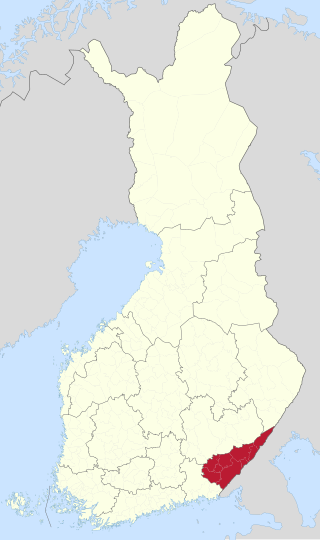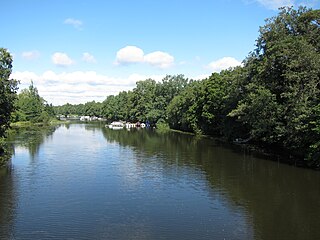
The Winter War, also known as the First Soviet-Finnish War, was a war between the Soviet Union and Finland. The war began with a Soviet invasion of Finland on 30 November 1939, three months after the outbreak of World War II, and ended three and a half months later with the Moscow Peace Treaty on 13 March 1940. Despite superior military strength, especially in tanks and aircraft, the Soviet Union suffered severe losses and initially made little headway. The League of Nations deemed the attack illegal and expelled the Soviet Union from the organisation.

The Republic of Karelia, also known as just Karelia, is a republic of Russia situated in Northwest Russia. The republic is a part of the Northwestern Federal District, and covers an area of 172,400 square kilometres, with a population of 533,121 residents. Its capital is Petrozavodsk.

The Karelo-Finnish Soviet Socialist Republic, also called Soviet Karelia or simply known as Karelia, was a republic of the Soviet Union. It existed from 1940 until it was made part of the Russian SFSR in 1956 as the Karelian Autonomous Soviet Socialist Republic. The latter became the Republic of Karelia, a federal subject of Russia, on 13 November 1991.

Joensuu is a city and municipality in North Karelia, Finland, located on the northern shore of Lake Pyhäselkä at the mouth of the Pielinen River (Pielisjoki). It was founded in 1848. The population of Joensuu is 77,480, and the economic region of Joensuu has a population of 115,000. It is the 12th largest city in Finland. The nearest major city, Kuopio in North Savonia, is located 136 kilometres (85 mi) to the west. From Joensuu, the distance to Lappeenranta, the capital of South Karelia, is 233 kilometres (145 mi) along Highway 6.

The Finnish Army is the land forces branch of the Finnish Defence Forces. The Finnish Army is divided into six branches: the infantry, field artillery, anti-aircraft artillery, engineers, signals, and materiel troops. The commander of the Finnish Army since 1 January 2022 is Lieutenant General Pasi Välimäki.

Karelians are a Finnic ethnic group who are indigenous to the historical region of Karelia, which is today split between Finland and Russia. Karelians living in Russian Karelia are considered a distinct ethnic group closely related to Finnish Karelians, who are considered a subset of Finns. This distinction historically arose from Karelia having been fought over and eventually split between Sweden and Novgorod, resulting in Karelians being under different cultural spheres.

North Karelia is a region in eastern Finland. It borders the regions of Kainuu, North Savo, South Savo and South Karelia, as well as Russia's Republic of Karelia. It is the easternmost region of Finland and shares a 300 kilometres (190 mi) border with Russia. The city of Joensuu is the capital and the largest settlement of the region.

South Karelia is a region of Finland. It borders the regions of Kymenlaakso, South Savo and North Karelia, as well as Russia.
Karelia, the land of the Karelian people, is an area in Northern Europe of historical significance for Russia, Finland, and Sweden. It is currently divided between northwestern Russia and Finland.

South Savo is a region in the south-east of Finland. It borders the regions of North Savo, North Karelia, South Karelia, Kymenlaakso, Päijät-Häme, and Central Finland. The total area of South Savo is 18,768.33 km2, with a population of 153,738 (2011). South Savo is located in the heart of the Finnish lake district, and contains Lake Saimaa, the largest lake in Finland. The three major towns in the region are Mikkeli, Savonlinna and Pieksämäki.

Sortavala ; till 1918 Serdobol is a town in the Republic of Karelia, Russia, located at the northern tip of Lake Ladoga near the Finnish border, 246 kilometres (153 mi) west of Petrozavodsk, the capital city of the Republic of Karelia. The closest city on the Finnish side of the border is Joensuu, which is located 136 kilometres (85 mi) from Sortavala. In 2021 the population of Sortavala was 19,215.

Kymenlaakso is a region in Finland. It borders the regions of Uusimaa, Päijät-Häme, South Savo and South Karelia and Russia. Its name means literally The Valley of River Kymi. Kymijoki is one of the biggest rivers in Finland with a drainage basin with 11% of the area of Finland. The city of Kotka with 51,000 inhabitants is located at the delta of River Kymi and has the most important import harbour in Finland. Other cities are Kouvola further in the inland which has after a municipal merger 81,000 inhabitants and the old bastion town Hamina.

The Karelian question or Karelian issue is a dispute in Finnish politics over whether to try to regain control over eastern Karelia and other territories ceded to the Soviet Union in the Winter War and the Continuation War. Despite the name "Karelian question", the term may refer also to the return of Petsamo, ceded parts of Salla and Kuusamo, and four islands in the Gulf of Finland. Sometimes the phrase "debate on the return of the ceded territories" is used. The Karelian question remains a matter of public debate rather than a political issue.

Greater Finland, an irredentist and nationalist idea, emphasized territorial expansion of Finland. The most common concept of Greater Finland saw the country as defined by natural borders encompassing the territories inhabited by Finns and Karelians, ranging from the White Sea to Lake Onega and along the Svir River and Neva River—or, more modestly, the Sestra River—to the Gulf of Finland. Some proponents also included the Torne Valley, Ingria, and Estonia.

Karelia has appeared in philately several times; first as a breakaway republic from Soviet Russia in 1922, later when Eastern Karelia was occupied by Finland during the Continuation War of 1941 to 1944, and in the post-Soviet period when provisional stamps and cinderellas were issued. Additionally, there were Zemstvo stamps used in the early 20th century on the territory of the contemporary Republic of Karelia.
7th Division was a Finnish Army division in the Continuation War. The division was formed Savo-Karjala military province from the men in Pohjois-Savo and Pohjois-Karjala civil guard districts.

Savo-Karelia is one of the 13 electoral districts of the Parliament of Finland, the national legislature of Finland. The district was established in 2013 by the merger of North Karelia and North Savo districts. It is conterminous with the regions of North Karelia and North Savo. The district currently elects 15 of the 200 members of the Parliament of Finland using the open party-list proportional representation electoral system. At the 2019 parliamentary election it had 342,671 registered electors.
The I Corps refers to several short-lived units of the Finnish Army before and during the Continuation War. The longest-lived I Corps participated in both the Finnish invasion of Ladoga Karelia and the Finnish invasion of the Karelian Isthmus in 1941 before being disbanded in early 1942, before being re-designated V Corps.
The VII Corps was a corps of the Finnish Army during the Continuation War of 1941 to 1944, where the Finnish Army fought alongside Germans against the Soviet Union. Under command of Major General Woldemar Hägglund, it took part in the Finnish invasions of Ladoga Karelia and East Karelia, including the capture of Petrozavodsk. During its existence, its composition varied significantly. It was disbanded in May 1943.
Karelians, also known as Finnish Karelians or Karelian Finns, are a subgroup (heimo) of the Finnish people, traditionally living in Finnish Karelia. A portion of Finnish Karelia was ceded to the Soviet Union following the Winter War. The portion still in Finland comprises the regions of North Karelia, South Karelia, and eastern Kymenlaakso. Over 400,000 Karelians were evacuated to other parts of Finland following the cession, and their descendants are now spread across the country, many still maintaining Karelian identities.


















